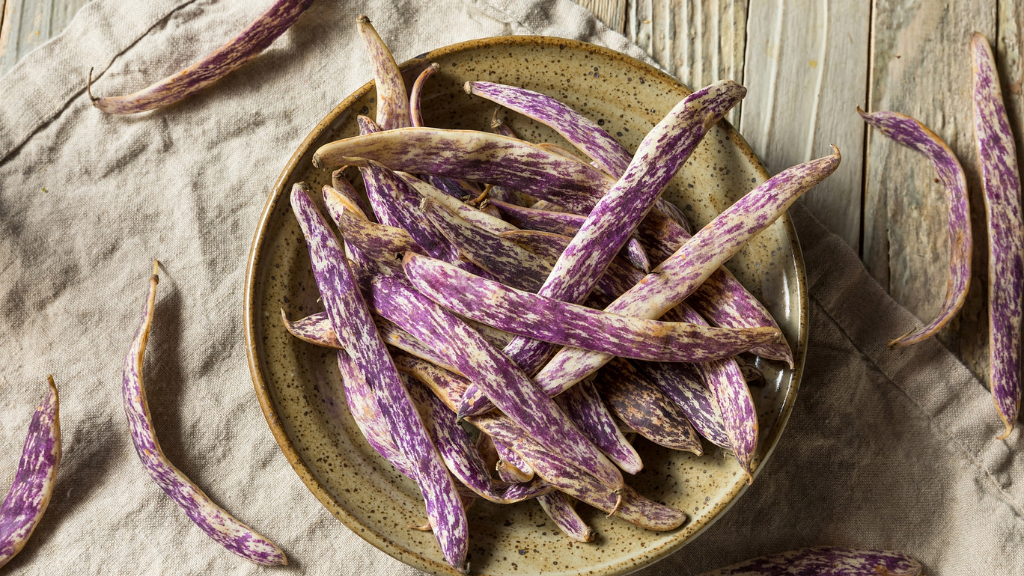History Of Dragon Tongue Beans

The name alone, Dragon Tongue bean plant, makes me want to grow these babies, but if that doesn't entice you to grow them, then maybe the fact that they are a dual use bean will. What does "dual use" mean? We'll get to that; let's indulge in a little history of Dragon Tongue beans first.
History of Dragon Tongue Beans
Dragon Tongue bean plants were first cultivated in the Netherlands in the 18th century and are a member of the Fabaceae family, as are peas and pulses (dry beans). Also known as Dragon Langerie beans, this bean varietal is a knockout with a creamy yellow interior and a dazzling, purple striated exterior. Beans attain an average of 6 inches in length and bear 4-6 seeds per stringless pod.
The entire bean can be eaten raw or cooked, but if you expect to retain that brilliant color, think again. Cooked beans lose their gorgeous hues. Back to growing Dragon Tongue bush beans as a dual use bean.
These open pollinated heirloom beans can be eaten young, in their entirety as a fresh snap bean, or pods can be harvested when fully mature for shelling beans. Seeds are firm, slightly starchy, sweet and nutty.
This "romano" or wax type bush bean is less fibrous than other snap beans. The eye popping color of Dragon Tongue beans is sure to be a conversation starter on the crudités platter, or they make a delicious side dish. Great in stir fries, bean salads and especially suited for pickling. Beans can be stored in plastic in the fridge for about one week; use 'em or lose 'em!
Growing Dragon Tongue Bush Beans
These guys have been naturalized in a variety of climates throughout North and into South and Central America, so it adapts to a wide range of heat and humidity levels. They tend to have a high yield with a superior flavor over other fresh bean types.
Now that I have piqued your interest, I'm sure you will want to know how to grow your own Dragon Tongues. If you can grow typical beans, then you can grow these. Direct sow Dragon Tongue seeds after all danger of frost has passed to a depth of one inch, 2 inches apart in rows 36-48 inches apart in full sun exposure. Harvest the beans between 55-60 days. Leave beans on to mature if desirous of dried beans.
Gardening tips, videos, info and more delivered right to your inbox!
Sign up for the Gardening Know How newsletter today and receive a free copy of our e-book "How to Grow Delicious Tomatoes".
The more often you harvest, the bigger your yield will be. Plants will be 24-30 inches tall. Dragon Tongues are delicious simply steamed and tossed with butter or olive oil and cracked pepper and kosher salt, or you can step it up a notch and blanch, then sauté with an accompanying flavor such as a bit of garlic or shallot and crispy pancetta.
Combining these guys with buttery Yellow Finn potatoes, steamed and cooled, then tossed in mustard vinaigrette is mmm-mmm good too. Or make pickled green beans to prolong your enjoyment of this luscious bean variety or to give as gifts that will titillate your friends and make them want to grow Dragon Tongue heirlooms.

Amy Grant has been gardening for 30 years and writing for 15. A professional chef and caterer, Amy's area of expertise is culinary gardening.
-
 ‘Coral Charm’ Peony Care For Sublime Semi-Double Peonies With Lush Salmon Pink Flowers
‘Coral Charm’ Peony Care For Sublime Semi-Double Peonies With Lush Salmon Pink FlowersPeonies are known for their soft baby pink or magenta tones, but if plushy coral blooms are your thing, here’s our guide to the ultimate ‘Coral Charm’ peony care
By Tonya Barnett
-
 How To Grow Seeds Quickly: 8 Expert Tricks For Fast Flowers & Crops
How To Grow Seeds Quickly: 8 Expert Tricks For Fast Flowers & CropsIt's never too late to start growing! Jump-start your flower or vegetable garden with these pro tips and tricks for germinating seeds in record time.
By Amy Grant